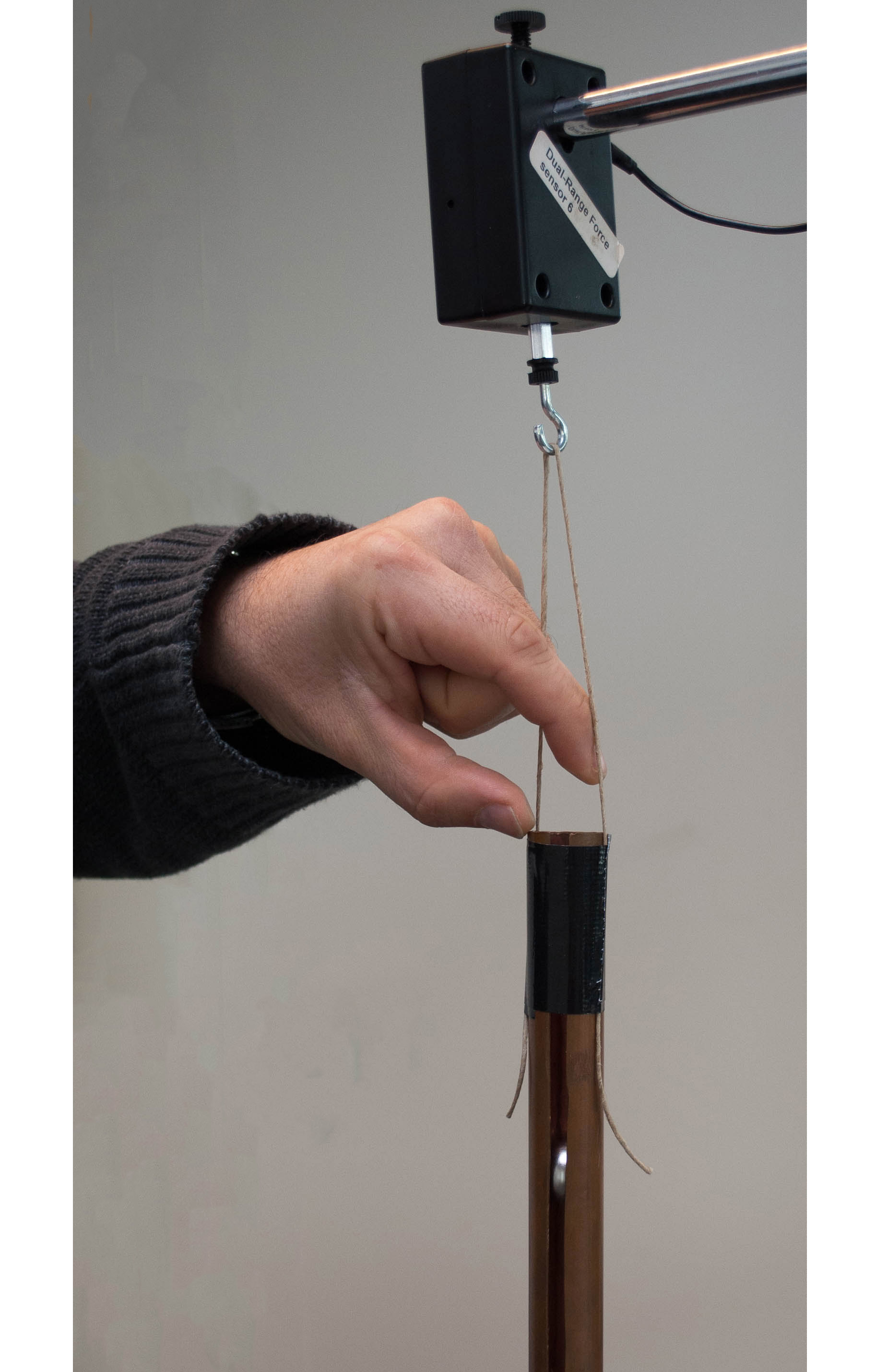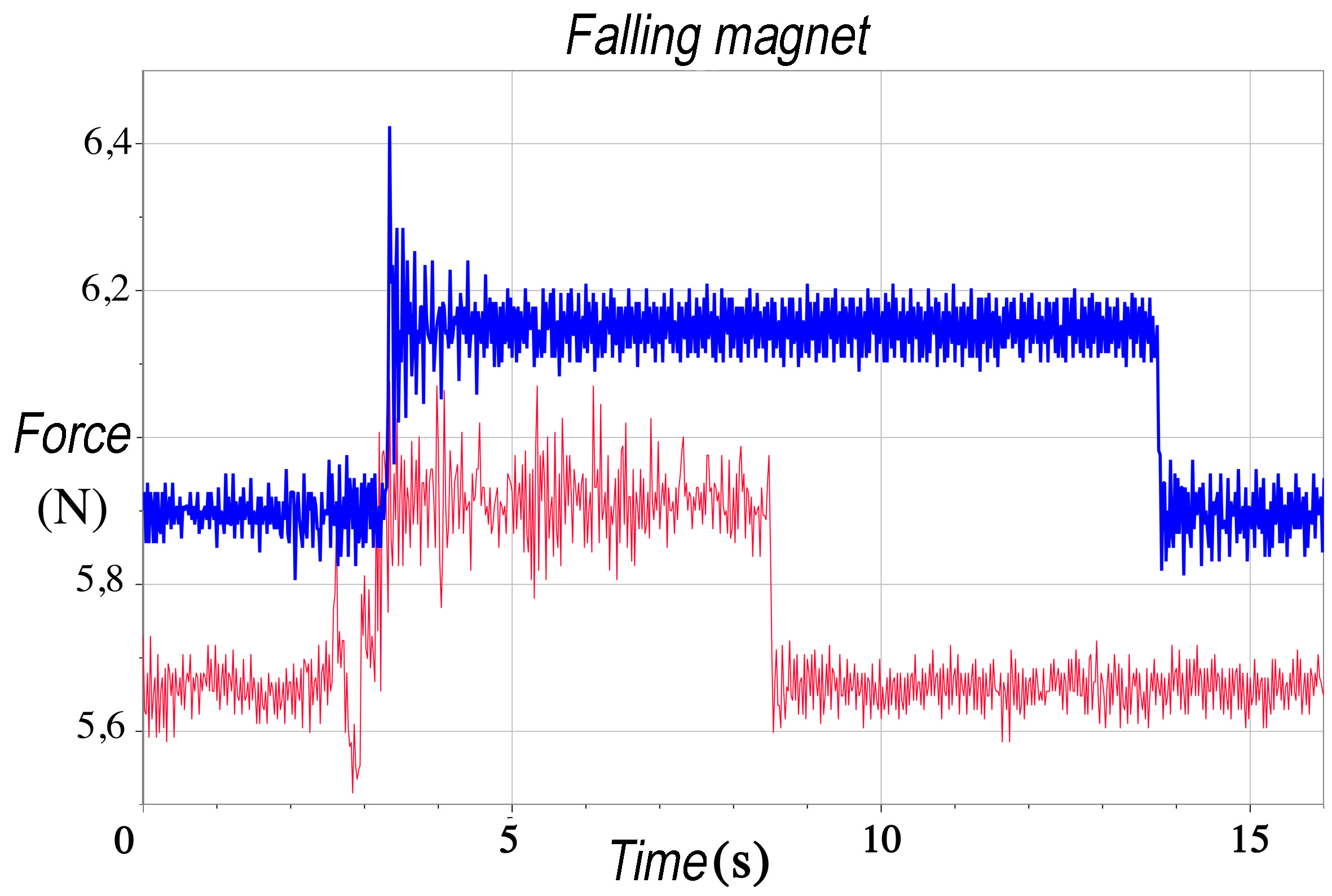17.7. Does the magnet challenge gravity?#
Falling magnet and Newton’s third law
| Author: | Wouter Spaan |
| Time: | 10-15 minutes, extendable |
| Age group: | 16+ |
| Concepts: | Newton's first, second and third law, constant velocity, Lenz |
Introduction#
A magnet falling slowly through a copper tube (showing Lenz’ law) is a well-known demonstration. It is possible to use the same phenomenon as an interesting, surprising and challenging application of Newton’s Third Law. In order to be able to measure with this set-up, the tube is suspended from a force sensor which measures its weight. This demonstration is not suitable to introduce Newton’s third Law. However, it can provide an adequate test of its application with senior high students.
Equipment#
Copper tube
Force sensor / weight scale
Small strong magnet
(Copper tube cut open)
(Stronger magnet)
Preparation#
Build the experimental set-up as pictured in Figure 17.13. Test the force sensor and the required settings (software).

Fig. 17.13 The experimental setup with the copper tube attached to the force sensor. The tube can be both closed and open. In this picture the tube is open ended.#
Procedure#
The students are probably familiar with a magnet falling slowly through a copper tube. If not, make sure to show it in advance. The explanation of the phenomenon is not strictly required for the learning goals mentioned, but your students are probably curious to know. You can explain Lenz’ law, see e.g. Induction tubes.
The next step is attach the tube to the force sensor and show a measurement of the force for a couple of seconds (without the magnet). It will show the weight of the tube, which equals the gravitational force on the tube.
Next, you ask your students what will happen to the measured force when you drop the magnet in the tube. Ideally all students should get a chance to draw a graph, e.g. by using small white-boards. Instruct them to draw three distinct parts:
- before the magnet has been dropped in the tube,
- while the magnet is falling, and
- after the magnet has left the tube.
This will result in different graphs. Only after a thorough discussion, you show the experiment. Then you can ask your students to explain the result using a free body diagram showing all the forces on the magnet and on the tube, while the magnet has a constant velocity. During the closing discussion you can emphasize the importance of the constant speed.

Fig. 17.14 The force-time diagram when the magnet falls through the tube. The blue line is the closed tube, the red the open tube. The ‘additional’ measured force is in both cases the same and equal to the gravitational force acting on the magnet.#
As an important check whether the explanation is clear and students can apply it themselves an additional experiment can be performed with the open tube. In this case the magnet will fall faster than in the uncut tube (but still considerably slower than in free fall). Ask the students to predict whether the increase in force is larger than, equal to or smaller than the increase measured with the uncut tube. Some students will persist in their preconception and you will probably hear comments like: ‘The speed of the magnet is higher and so is the increase in force’ or ‘The magnet is decelerated less, and so is the increase in force’. Lastly you can compare the measured increase with the weight of the magnet (at rest).
Tip
Take your time to make and explain all drawings (\(F,t\)-diagrams and force-diagrams).
This demonstration provides an interesting opportunity to discuss the concept of apparent weightlessness. Is the magnet weightless during its fall?
A small notch in the tube, as displayed in the movie clip, allows for more detailed discussion.
Physics background#
The induced magnetic field in the tube will provide a repelling force on the magnet, which prevents it from accelerating like in free fall. The magnet in turn provides an equal and downward force on the tube. Therefore, the force required to lift the tube increases with the same amount. It is this force you measure with the sensor. Once the magnet reaches a constant speed (which happens very fast), the increase in force is equal to the gravity on the magnet as the net force on the magnet equals zero.
Follow-up#
With the open tube, the force is less constant than with the closed tube. In the open tube one can see the magnet rotating. Perhaps rotation is less in a closed tube. Why would that be?
